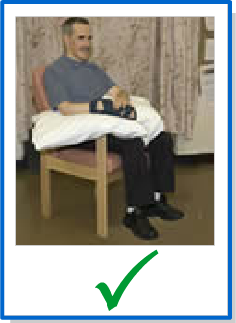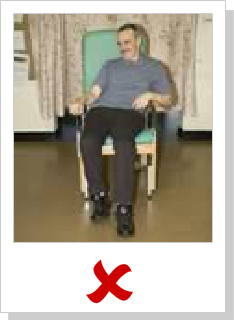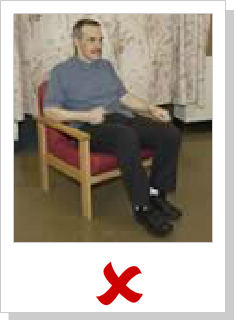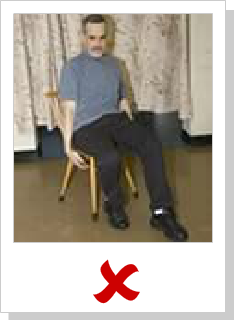Once you’ve had a go at figuring out the correct options for yourself, click on the item below to expand it and see what happens when Mr McTavish is put into each chair.
Images numbered from left to right:
Correct options
 Image 2 – width 18 inches (46 cm), depth 18 inches (46 cm), platform to seat 18 inches (46 cm). This chair is appropriate for Mr McTavish.
Image 2 – width 18 inches (46 cm), depth 18 inches (46 cm), platform to seat 18 inches (46 cm). This chair is appropriate for Mr McTavish.
 Image 5 – width 18 inches (46 cm), depth 18 inches (46 cm), footrest to seat 18 inches (46 cm). This chair could be useful for Mr McTavish but only for short-term transportation purposes.
Image 5 – width 18 inches (46 cm), depth 18 inches (46 cm), footrest to seat 18 inches (46 cm). This chair could be useful for Mr McTavish but only for short-term transportation purposes.

Incorrect options
 Image 1 – width 22 inches (56 cm), depth 18 inches (46 cm), floor to seat 18 inches (46 cm). This chair is too wide.
Image 1 – width 22 inches (56 cm), depth 18 inches (46 cm), floor to seat 18 inches (46 cm). This chair is too wide.
 Image 3 – width 18 inches (46 cm), depth 14 inches (36 cm), floor to seat 14 inches (36 cm). This chair is too short and too low.
Image 3 – width 18 inches (46 cm), depth 14 inches (36 cm), floor to seat 14 inches (36 cm). This chair is too short and too low.
 Image 4 – width 14 inches (36 cm), depth 18 inches (46 cm), floor to seat 18 inches (46 cm). This chair has no arm support.
Image 4 – width 14 inches (36 cm), depth 18 inches (46 cm), floor to seat 18 inches (46 cm). This chair has no arm support.
Page last reviewed: 01 Feb 2021


